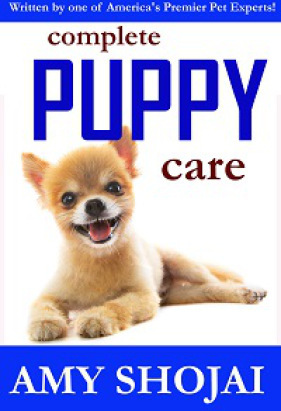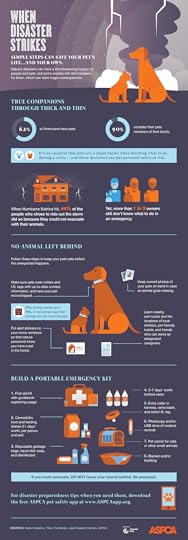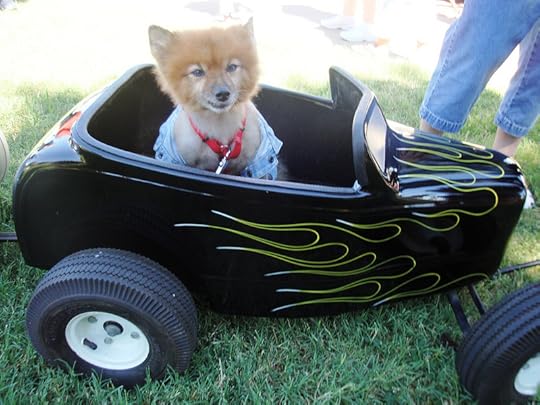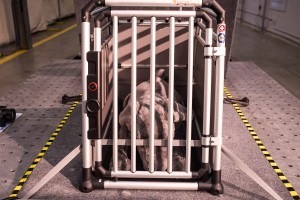Amy Shojai's Blog, page 88
September 7, 2015
Puppy Diarrhea, Home Remedies & When to Call The Vet
Puppy diarrhea ranks near the top as a common puppy problem, and being familiar with dog diarrhea treatment is important. Mild cases may be treated at home and get better but diarrhea can be deadly especially for puppies.
When you have a dog, poop happens. Knowing what to do is key, and it’s vital to recognize the difference between an aggravation and an emergency, and what to do with both.
Diarrhea isn’t disease. It’s a sign of illness, and may be caused by many different conditions.
Causes Of Puppy Diarrhea
Diarrhea can be associated with viruses such as parvovirus and distemper. It also can be caused by intestinal parasites like whipworms, hookworms; protozoan such as giardia, bacterium like salmonella and E. coli. Some types of intestinal parasites can be very difficult for veterinary tests to detect and it can take many tests over weeks to obtain a diagnosis.
Puppies also may develop diarrhea from a sudden change of diet. The stress of coming to a new home could prompt loose stools. Overfeeding or eating out of the garbage also causes tummy upsets. Without knowing the cause, the right treatment can’t be suggested.
[image error] See The Vet Immediately!
Diarrhea can point to conditions that could kill your puppy. Don’t wait—the resulting dehydration can make puppies even sicker.
A couple of years ago, Magic suffered from a bout of explosive diarrhea. I’d been called for jury duty, so I was gone–and discovered his illness when I returned home after the first day of service. Yikes! Magic had been drinking from the water-filled tank (aka man-made pond) on our property, and we suspected the run-off infected him with some type of parasite. It required a couple of weeks of medication for him to feel better. Had he been a baby, the situation could have been life-threatening. See the veterinarian immediately if your puppy’s diarrhea:
Looks black with a tar-like consistency
Smells extremely foul
Contains large amounts of red blood
Diarrhea is accompanied by vomiting, severe pain, fever, appetite loss or lethargy.
How to Treat Dog Diarrhea At Home
It’s always best to get a vet check first. But your vet may recommend milder forms of diarrhea be treated at home. For instance, if it’s been less than three days, the dog or puppy still feels and acts well, and the diarrhea has a pudding-like appearance, home care may help.
Until you see the vet, withhold food for 12 to 24 hours. That rests the gut and gives the irritation a chance to heal. Also, if there’s nothing going into your pet, there won’t be anything to come out. However, don’t withhold food any longer than that without advice from your veterinarian. In particular, tiny puppies and even adult toy-breed dogs may “crash” if they don’t eat often enough.
Make sure that water remains always available. It’s very easy for puppies to quickly become dehydrated. A sudden watery diarrhea can spill large amounts of fluid and important minerals out of the body. To check if your pet is dehydrated, firmly grasp the “scruff” (loose skin over the shoulders) and gently pull up and release. If it doesn’t snap back immediately but takes time to settle, your pet likely suffers from dehydration. If your dog acts reluctant to drink, offer him ice cubes to lick. Pedialyte or Gatorade mixed 50/50 with water can counter the dehydration if he’ll drink it.
Pepto-Bismol and Kaopectate may help your dog if he likes the taste (some don’t!). Use a needle-less syringe or a turkey baster to squirt the medicine into his mouth. Your vet will let you know the proper dosage, if it’s appropriate for your pup’s situation.
It often takes a couple of days for your puppy’s tummy to calm down, and a bland diet can help. Offer plain white rice or macaroni cooked until very soft in plain no-salt chicken broth. Stir in a tablespoon of low fat cottage cheese or plain yogurt for more flavor. Yogurt contains beneficial bacteria, which helps re-balance the disruption caused by the diarrhea. The high fiber of pumpkin can help with either constipation or diarrhea to help normalize the stool.
You’ll find all the must-know puppy-licious info in the book COMPLETE PUPPY CARE (much of it applies to adult dogs, too!).
Has your dog ever suffered from diarrhea? Seems like it always happens on a holiday or weekend, too! What did you do? Although dealing with diarrhea stinks, knowing  what to do can ensure that everything comes out all right. Literally.
what to do can ensure that everything comes out all right. Literally.
I love hearing from you, so please share comments and questions. Do you have an ASK AMY question you’d like answered–click the banner, above. Be sure to visit my PetHealthyStore for paw-some products for your furry wonders! Stay up to date on all the latest just subscribe the blog, “like” me on Facebook,and get a FREE BOOK when you sign up for Pet Peeves newsletter. Want the insider info on the latest books and appearances? Join my team and get advance sneak peaks related to my THRILLERS WITH BITE!
August 31, 2015
Do Cats Suffer Separation Anxiety? Signs & Tips to Relieve the Angst

Back to school can change schedules and put kitty’s tail in a twist.
Cat separation anxiety requires behavior modification and desensitization to soothe upset kitty feelings and reverse problem behaviors. Cats may go for years without issues, and then suddenly act out when your work schedule changes and keeps you away for long hours. Vacations also tend to trigger feline separation anxiety. Think of separation anxiety as a form of grief. Cats don’t mean to “act bad,” they just miss you so much they can’t help themselves.

Cats KNOW when you’re supposed to come home…don’t disappoint the kitty!
Scented Comfort
Like dogs with the same condition, cats may cry and become upset as you prepare to leave. More often, they don’t react to your departure. They wait to “act out” once left alone, and urinate and defecate on owner-scented objects—most typically the bed.
The familiar scent of kitty’s bathroom deposits actually comforts her, and reducesfeelings of stress. Of course, these unwelcome “gifts” increase owner stress levels. And while angry reaction is understandable, your upset feelings increase the cat’s anxiety even more.
Cats don’t potty on the bed to get back at you because you left. Think of the cat’s behavior as a backhanded compliment. Kitty wouldn’t do this if she didn’t love you so much!

Missing you adds stress that can even lead to illness.
Desensitize and Counter-Condition
Cats pay exquisite attention to the details of their lives. They’ll often recognize subtle clues that you’re preparing to leave long before you realize. A cat may figure out that you always freshen your lipstick just before you leave. Repeating these cues takes away their power.
Desensitize your cats to the presence of the overnight bag by leaving it out all the time. Put clothes in and out of the bag every day, but without leaving the house, so your cat no longer gets upset when she sees you pack.
Toss a catnip mouse inside the suitcase, and turn it into a kitty playground. That conditions her to identify the suitcase as a happy place, rather than associating it with your absence.
Use behavior modification techniques so the triggers lose their power. Pick up the car keys 50 times a day, and then set them down. Carry your purse over your arm for an hour or more. When you repeat cues often enough, your cat stops caring about them and will remain calm when you do leave.
Fake your departure by opening the door and going in and out twenty or more times in a row until the cat ignores you altogether. Then extend your “outside” time to one minute, three minutes, five minutes and so on before returning inside. This gradual increase in absence helps build the cat’s tolerance and desensitizes her to departures. It also teaches her that no matter how long you’re gone, you always return.
More Tips for Reducing Angst
Most problem behaviors take place within twenty minutes after you leave. The length of time you’re absent doesn’t seem to matter. Find ways to distract the cat during this critical twenty minutes so she won’t dirty your bed.
Ask another family member to interact with the cat during this time. A fishing-pole lure toy or chasing the beam of a flashlight can take the cat’s mind off her troubles. If she enjoys petting or grooming, indulge her in a touchy-feely marathon.
About 1/3rd of cats react strongly, another 1/3rd react mildly, and the last 1/3rd don’t react at all to catnip. If your feline goes bonkers for this harmless herb, leave a catnip treat to keep her happy when you leave. Using catnip every day can reduce its effects, though, so use this judiciously.
Food oriented cats can be distracted with a food-puzzle toy stuffed with a favorite treat. Make it extra smelly, irresistible and something totally different than her usual fare to be sure the treat makes the proper impression.
Cats that have been outside and seen the real thing often don’t react, but homebody indoor-only cats enjoy watching videos of fluttering birds, squirrels and other critters. There are a number of these videos available, including the original called “Video Catnip.” Alternately, find a nature television show such as on Animal Planet, and tune in for your cat’s viewing pleasure.
Playing familiar music that they associate with your presence can help ease the pain of you being gone. In addition, research has shown harp music works as a natural sedative, and actually puts cats to sleep. Harp music CDs designed for this purpose can be found at petpause2000.com.
 Not all tips work with every cat, since every feline is an individual. But using these techniques alone or in combination can heal upset kitty feelings, and turn homecomings into joyful reunions. You’ll find lots more tips in my cat behavior book COMPETABILITY: Solving Behavior Problems in Your Multi-Cat Household.
Not all tips work with every cat, since every feline is an individual. But using these techniques alone or in combination can heal upset kitty feelings, and turn homecomings into joyful reunions. You’ll find lots more tips in my cat behavior book COMPETABILITY: Solving Behavior Problems in Your Multi-Cat Household.
What kinds of things have helped with YOUR cat? Do tell!
I love hearing from you, so please share comments and questions. Do you have an ASK AMY question you’d like answered–click the banner, above. Be sure to visit my PetHealthyStore for paw-some products for your furry wonders! Stay up to date on all the latest just subscribe the blog, “like” me on Facebook, and get a FREE BOOK when you sign up for Pet Peeves newsletter. Want the insider info on the latest books and appearances? Join my team and get advance sneak peaks related to my THRILLERS WITH BITE!
August 27, 2015
Cat Litter Box Problems? 7 Reasons Cats Snub the Box & What To Do #FoodShelterLove
This post is sponsored by Hill’s. I am being compensated for helping spread the word about Hill’s® Science Diet® and The Hill’s Food, Shelter & Love® Program, but Bling, Bitches & Blood only shares information relevant to our readers. Hill’s Pet Nutrition, Inc. is not responsible for the content of this article.

Too many sharing one potty is a recipe for failure! Image courtesy of DepositPhotos.com
The number one reason cats lose their homes and end up in animal shelters is litter box problems possibly caused by feline urinary health or hairball control problems. That’s also the top reason an adopted kitten or cat gets returned. How sad! There is no single reason for hit-or-miss potty problems, and therefore, no single “cure” for bad behavior, but you can find out what to do with these common reasons cats snub the box.
Folks generally assume that any litter box issue is due to a behavior problem, but you CANNOT separate health from behavior. The two go together like … like… laps and cats, or kittens and toys. Here are a few of the many reasons cats snub the litter box. Simply by keeping your cat healthy with good nutrition that supports urinary track health goes a long way, though.

Image courtesy of Hill’s Pet Products
Hill’s Pet Nutrition has recently introduced a new Urinary & Hairball Control formula because a healthy bladder starts with the right balance of vital nutrients. When you adopt your newest kitty family member, this could be the perfect choice to keep him or her healthy inside and out!
WHY CATS MISS THE LITTER BOX
Clueless Kittens. Your new baby does not come pre-programmed knowing what to do. Even if she copy-cat’d her mother’s behavior, a kitten may not know where the facilities are located, or be able to reach them in time. Make it easy for new kittens. For the first week or so, confine her in one room with a nearby litter box (and other kitty equipment) so she learns allegiance to the box. Put her in the box and praise when she’s productive.
Clueless Adults. Adult cats certainly know how to “go” but your home is new territory for them. Be sure the adopted cat knows where to find the litter boxes. Find out what type of litter pan and box filler the shelter used, and start out with the same kind (you can transition latter, if need be). If he’s previously been an outdoor cat, he may not recognize the litter pan as the toilet. Give him a clue: add a top-dusting of potting soil or leaves from outside.
Marking Territory. To cats, urine holds more fascinating, important information than my Kindle. Intact felines (both boys and girls) use urine like Match.com to advertise their availability and to cow interlopers from trespassing. Getting your cat spayed or neutered prior to sexual maturity reduces urine marking up to 90 percent. So don’t wait!

Seren now tolerates Karma. His pestering has led to litter box challenges. Image copr. Amy Shojai, CABC
Other Cats. Having to share potties puts many cats’ tails in a twist. Do YOU want to “go” after someone else? Didn’t think so. ;P Some cats want one box for solids and another for liquids. At age 19, Seren has not been happy about the interloper, Karma, and for the first time Seren has gone outside the box. She found a spot behind a bit chair, hidden from Karma but with two-way access, and left her “deposits” there. So…I got another litter box, cleaned the carpet thoroughly, and installed the new potty where she wanted it.
Making sure there are enough litter boxes reduces the competition so one top cat doesn’t guard the bathroom and prevent others from accessing it. I recommend the 1 1 rule: one box, per cat, plus one. The stress of other cats also can prompt urine marking, not just to claim territory, but to use self-scent to calm their frazzled kitty nerves.
Smelly Box. Keeping the toilet clean seems to be a no-brainer, but you’d be surprised how quickly the yucky stuff builds up. Get the cleanup on a schedule. Daily, no exceptions, will reduce the chance of lapses. And “smelly” may also mean “too perfume-y” according to your cat, so beware of strongly scented box fillers, too.

EEEK! This box is WAY too small! Image courtesy of DepositPhotos.com
Bad Facilities. Every cat is unique so what works for one may be awful for the next. Bad facilities may include a poor location, type of box, or kind of box filler.
Cats want privacy, but don’t want to feel trapped. Avoid placement in corners of rooms, or underneath cabinets, for instance. Locations that have a good lookout (so they can see the other cats coming and escape!) are ideal.
Most cats prefer soft, sandy textures easy on the paws for digging. They also like routine. So once you’ve found something they use faithfully, don’t mess with success.
Many commercial boxes are too small, and covered boxes contain odors and may make cats feel trapped. Experiment by offering a variety to see what your cat prefers. I like the translucent storage boxes from container stores, because they’re bigger for jumbo-size squatters, and the cat can see other cats approach.
Feline Urinary Health Problems. When your cat has been faithful to the potty and suddenly develops problems, your veterinarian should be the first call. There are a number of health issues that may underlie the cat’s litter box lapses. Painful urination or defecation may result in the cat “blaming” the box for the for the discomfort. When kitty hates the box, she’ll look elsewhere for a comfy spot to go–like under your potted palm. The proper diagnosis from your vet is vital in order to treat and often reverse the condition and poor behavior. Some signs of possible health conditions include any one or combination of the following:
break in house training
dribbling urine
straining in the litter box
Spending lots of time “posing” with little result
bloody urine or urine with a strong ammonia smell
crying during elimination
excessively licking the genitals
Some cats “go” in the sink or bathtub, or squat right in front of you (asking for help?)

Image courtesy of Hill’s Pet Products
Science Diet Urinary & Hairball Control is formulated to support the health of the whole urinary system, from kidneys to bladder, through an optimal level of magnesium and natural fiber to help avoid hairball formation in healthy adult cats. It is a maintenance product for healthy cats, and does not treat crystals. As always, Hill’s recommends that a pet parent consult their veterinarian and ask them to recommend the best food for their cat.
I love hearing from you, so please share comments and questions. Do you have an ASK AMY question you’d like answered–click the banner, above. Stay up to date on all the latest just subscribe the blog, “like” me on Facebook, and get a FREE BOOK when you sign up for Pet Peeves newsletter. Want the insider info on the latest books and appearances? Join my team and get advance sneak peaks related to my THRILLERS WITH BITE!
August 24, 2015
Don’t Go! Canine Separation Anxiety & What to Do

Back to school changes routines and can be a big trigger for canine separation anxiety.
Canine separation anxiety isn’t uncommon. According to veterinary behaviorists reporting at the Western Veterinary Conference, about fourteen percent of pet dogs seen in veterinary clinics suffer from problems being left alone. Puppies adopted before eight weeks of age, mixed breeds and pups adopted from shelters are at highest risk.
Affected puppies feel over-attachment to one or more family members. Problems develop when the amount of time you spend with the pet changes. Dogs are creatures of habit and love routine, so any change perhaps due to kids returning to school, your new job or a change in schedules can turn up the stress.

Something that smells like you–a blanket or stuffed toy–may be targeted by your dog to chew. The smell may also comfort and soothe him.
What Is Separation Anxiety?
Animal behaviorists recently have begun to use different terms to describe the condition. That’s because not all dogs become anxious when left alone, although they do act out. Separation distress doesn’t necessarily mean the pup feels anxious and probably is a more accurate description of dogs displaying separation behaviors.
Separation behaviors encompass a whole range of activities that might take place as a result of the puppy being left alone. Many times, dogs act out because they’re stressed or anxious at the owner’s absence.
But some behaviorists suggest that separation behaviors such as emptying your sock drawer or chewing up the toilet paper may arise out of boredom. This could be the canine equivalent of a teenager left alone by parents, and throwing a party. About the only way you can tell the difference is to set up a video camera while you are gone, and have it looked at by a behaviorist to see if the dog shows anxious behavior or simply appears to have a good time disemboweling the sofa cushions.

Not all dogs are anxious. Some simply throw a party out of boredom once you leave the premises.
What Are Separation Behaviors?
The dog follows you around the house and becomes increasingly upset as you prepare to leave.
When left alone, affected dogs act anxious or distressed, often become extremely vocal, and sometimes forget house training. They may destroy property either to escape or as a way to relieve stress.
Many dogs with separation anxiety target personal items. For instance, they chew up your shoes or a favorite purse. They aren’t retaliating for being left alone. Because these items smell like you, that can trigger anxiety that prompts destructive displacement behaviors. Dogs may also seek out objects that smell like you because your scent comforts them.
Dogs might even decide to mark with urine or defecate on something that smells like their owner. This isn’t to get back at you, but instead is the canine’s attempt to self-calm.
How To Calm Separation Behaviors
Pets should never be punished for any anxiety-based behavior because punishment makes it worse. If your puppy exhibits destructive separation behaviors, you can take steps to reduce the problem.
Your veterinarian may prescribe drug therapy that relieves the angst, such as Clomacalm (clomipramine hydrochloride), or Reconcile (Prozac or fluoxitine). But drugs alone won’t be a magic wand.
The most intense acting out happens within the first twenty to thirty minutes after you leave, and how long you’re gone doesn’t seem to matter. So if you can distract the dog during this critical period, much of his upset feelings will be relieved, and destructiveness may be eliminated.
Desensitize the dog to the triggers of departure. Pick up your car keys fifty times—but then don’t leave. Put on your coat or open the door a dozen times, then stay inside. Repetition of these cues makes them lose meaning so the pup doesn’t get upset, and remains calmer when you actually do leave.
Stage absences to build up the dog’s tolerance level. Leave for one minute, two minutes, four, ten minutes and so on. Do this ten or fifteen times in a row so that (just like with the keys) so the repetition makes it less important to the pooch.
Make sure the puppy gets lots of exercise before you leave, and after you return home. A tired pup is a better behaved pup. If he’s worn out, he’ll snooze rather than chew up the cushions.
Soothing music can also help calm anxiety. I like to use harp music, which acts like a natural sedative and keeps anxious dogs peaceful.
The Bach Flower Essence Rescue Remedy
 also can help dogs with anxieties. You can add the drops to the dog’s water bowl for all day sipping.
also can help dogs with anxieties. You can add the drops to the dog’s water bowl for all day sipping.You can also offer puzzle toys filled with tasty treats, and hide them around the house for the dog to find. When he’s thinking and hunting for treats, he can’t worry or develop a full-blown panic attack.
 You can learn lots more about dog care and behavior tips in COMPLETE PUPPY CARE. What have I missed? Please share any tips that have helped with your holy terriers!
You can learn lots more about dog care and behavior tips in COMPLETE PUPPY CARE. What have I missed? Please share any tips that have helped with your holy terriers!
I love hearing from you, so please share comments and questions. Do you have an ASK AMY question you’d like answered–click the banner, above. Be sure to visit my PetHealthyStore for paw-some products for your furry wonders! Stay up to date on all the latest just subscribe the blog, “like” me on Facebook, and get a FREE BOOK when you sign up for Pet Peeves newsletter. Want the insider info on the latest books and appearances? Join my team and get advance sneak peaks related to my THRILLERS WITH BITE!
August 23, 2015
Katrina Revisited: 10 Years Later, Are You Disaster-Ready? #NatlPrep
Today is the 10th anniversary of Hurricane Katrina. The ASPCA says that in addition to killing nearly 2,000 people, this disaster left 600,000 pets deceased or homeless.
Almost half (44%) of the people who refused to evacuate during Hurricane Katrina said they did so because they felt they could not bring their animals with them. Can you blame them? I couldn’t leave Magic, Karma or Seren behind!
Despite this tragedy, the ASPCA also says that a recent poll shows that 35% of pet owners still don’t have plans in place for the next big storm. Whether you’re in the path of a hurricane, wildfire, tornado, flash flood or any other disaster, we OWE IT TO OUR PETS to get prepared. Check out the infographic, below, for some easy tips.
It’s been 10 years since Hurricane Katrina. Are your pets safer? Pledge to be prepared here!

I love hearing from you, so please share comments and questions. Do you have an ASK AMY question you’d like answered–click the banner, above. Be sure to visit my PetHealthyStore for paw-some products for your furry wonders! Stay up to date on all the latest just subscribe the blog, “like” me on Facebook, and get a FREE BOOK when you sign up for Pet Peeves newsletter. Want the insider info on the latest books and appearances? Join my team and get advance sneak peaks related to my THRILLERS WITH BITE!
August 21, 2015
Must Know Puppy Care & Puppy Play Tips
 Reminder, gang…for some reason this poor lil’ puppy book hasn’t been widely adopted. So I’m again making it available for reviews. Message me in the comments if interested!
Reminder, gang…for some reason this poor lil’ puppy book hasn’t been widely adopted. So I’m again making it available for reviews. Message me in the comments if interested!
COMPLETE PUPPY CARE is now available for your puppy-licious reading pleasure. I’ve included a brief excerpt below about how to tell when GOOD puppy play tips over into DANGEROUS games. That’s just the tip of the furry info, though. Please share the news about this book with all your puppy and dog loving peeps.
WANT A FREE PDF TO REVIEW?
COMPLETE PUPPY CARE includes more than two-dozen SQUEEE! cute puppy pictures (including Magical-Dawg as a baby), plus all the puppy must-knows. Those who subscribe to my PET PEEVES newsletter (click here & get another book free!) got the news early–and TEN folks won a free copy in exchange for posting an honest review. I’m nervously nail-biting until those get posted!
I’ll make the same offer here–post in the comments for a chance to review a free PDF copy of the book (the first 10 requests get the book!).
ABOUT COMPLETE PUPPY CARE…
Nothing beats a cute puppy for love, but proper puppy care and training prepares you and your new dog for a healthy and long life together. This up to date new guide provides a “Puppies 101” packed with veterinary facts, health care advice, how-to tips, and fascinating information about:
Choosing, training and communicating with your new puppy
Pros and cons of purebred versus shelter/rescue sources
Understanding common behavior problems and how to prevent them
Food, grooming and humane training recommendations
Tips for introducing your puppy to adult dogs, cats, babies and kids
The latest veterinary recommendations for preventive care
How to recognizing common health issues, and what to do
First aid and home remedies that save you money—and your puppy’s life!
More than two-dozen SQUEE! cute puppy pictures
Canine legends, myths and fun puppy facts including: Why puppies drink from the toilet, why dogs act guilty, reasons dogs hump your leg, and more!
COMPLETE PUPPY CARE empowers you with all the information necessary for your puppy to grow up into the happy, healthy dog you both deserve.
“Just Kidding” During Play
Dogs use exaggerated behaviors, called meta signals, to tell other dogs all action that comes after is not serious but a game. For instance, the play-bow is a butt-in-the-air with front-end down position where the pup’s forelegs dance back and forth to invite play. When your puppy first play-bows, he’s
telling you that any growls or wrestling that comes after are meant as fun and games.
Adult dogs often “pretend” to be subordinate to a puppy—with play bows or rolling on the back—to build up the pup’s confidence and invite him to play. This “just kidding” game allows lower-ranking pups to practice being in charge with play bites, mounting behavior, and wrestling games. Once the
play is over, the higher-ranking dog again assumes his more “mature” behavior that tells the pup to respect his leadership.
BAD VS GOOD PLAY—KNOWING THE DIFFERENCE
Dogs of all ages enjoy playing. Behaviors for fighting and fun are similar, but you must know how to tell the difference between aggression and play-acting. Watch for “meta signals” which tells participants that whatever comes after is meant in a “play” context.
Dogs commonly drop toys on your feet or lap to solicit a game, and offer toys to other dogs in the same way. A play bow—the dog sticks his butt and tail into the air, and bows forward on lowered forelegs that dance side to side—is the classic signal and invitation for the games to begin. Often, the
“fighting” behaviors seen during such games will be exaggerated to indicate play, or the “fight” behavior sequences may be jumbled.
Play includes inhibited mouth-open bites often aimed at the legs and paws of other dogs. Dogs also paw and bat each other without force to hurt. In appropriate play, all the dogs willingly participate. If you suspect one of the dogs doesn’t like the activity (one dog repeatedly tries to escape or hide),
gently separate the pair to see if they go back for more. If the play session was too rough, one will sneak away.
Inappropriate play results in one or more dog frightened, hurt, or overwhelmed. Bully dogs always end up on top, while in appropriate play you’ll see dogs take turns chasing and pinning each other during wrestling. Mouthing aimed primarily at the head or neck, or uninhibited bites means play has gotten out of hand. You’ll hear yelps from the bitten dog.
Consistent play up on hind legs may indicate problems. Ongoing mounting, clasping and thrusting also can lead to problems, as can resting of paws, heads or whole bodies across other dog’s shoulders to intimidate or achieve social status.
Growls don’t usually indicate problems, but play can be so exciting that the action escalates into aggression. Listen for louder, lower pitched growls,and be prepared to break up the session before they get too aroused.
***
Okay now, what about YOUR puppies and dogs? How do they play? Is it polite, taking turns, or is there some bully behavior involved? At my house, Magical-Dawg’s best play buddy is Karma-Kat and that involves a whole new set of signals.
Don’t forget–post your comment for a chance to review a free copy of the book!
I love hearing from you, so please share comments and questions. Do you have an ASK AMY question you’d like answered–click the banner, above. Be sure to visit my PetHealthyStore for paw-some products for your furry wonders! Stay up to date on all the latest just subscribe the blog, “like” me on Facebook, and get a FREE BOOK when you sign up for Pet Peeves newsletter. Want the insider info on the latest books and appearances? Join my team and get advance sneak peaks related to my THRILLERS WITH BITE!
August 20, 2015
Vet Visits Don’t Have to Be Stressful! #Cat2VetDay
Tomorrow is NATIONAL TAKE YOUR CAT TO THE VET DAY! I wrote about this earlier in the week here, and today you get some more tips for making the experience better for both you, and your cat.
But but but…kitty HATES the carrier, you say? I’ve written extensively about this in the past, and for a refresher check this link. You’ll find a PAW-some video in training cats to the carrier from the Catalyst Council in this video, too:
The American Association of Feline Practitioners (AAFP) have also provided the nifty infographic, below, as well as a great article YOU CAN SHARE on your blogs, tweets, facebook and anywhere else. Please read and share 5 De-Stressing Tips for Cats.
Now…have you called your vet for an appointment? Ready–set–CALL!

I love hearing from you, so please share comments and questions. Do you have an ASK AMY question you’d like answered–click the banner, above. Be sure to visit my PetHealthyStore for paw-some products for your furry wonders! Stay up to date on all the latest just subscribe the blog, “like” me on Facebook, and get a FREE BOOK when you sign up for Pet Peeves newsletter. Want the insider info on the latest books and appearances? Join my team and get advance sneak peaks related to my THRILLERS WITH BITE!
August 19, 2015
National Bring Your Cat to the Vet Day #Cat2VetDay

The “laying on of paws” does not replace proper vet care!
Saturday, August 22, is “National Bring Your Cat to the Vet Day” (#Cat2VetDay) and the American Association of Feline Practitioners (AAFP) is using this as an opportunity to educate cat owners on the importance of routine check-ups. Eighty-three percent of cats are taken to the vet in the first year of ownership, yet over half of them don’t return!
Now, y’all know I have a boatload of books available about how to care for your furry wonders, from kittenhood to old age, first aid and everything in between. But a book or an Internet search is NOT how best to care for your cat! Kitty needs hands-on whisker-to-vet interaction to ensure s/he’s healthy and will maintain that health for all of her nine lives. By the time you notice something may be amiss, it’s likely been percolating for a while…
How can you help?
Check out the PAW-some Infographic, below.
Please TWEET about this using the #Cat2VetDay hashtag.
CALL your vet today and make an appointment for your furry wonders.
SHARE on Facebook. We need to get our cats some furry love.
Oh, and here’s another great resources, a PDF you can share far and wide with more great info: 5 Cat-Tastic Benefits of Routine Vet Visits!

I love hearing from you, so please share comments and questions. Do you have an ASK AMY question you’d like answered–click the banner, above. Be sure to visit my PetHealthyStore for paw-some products for your furry wonders! Stay up to date on all the latest just subscribe the blog, “like” me on Facebook, and get a FREE BOOK when you sign up for Pet Peeves newsletter. Want the insider info on the latest books and appearances? Join my team and get advance sneak peaks related to my THRILLERS WITH BITE!
August 18, 2015
Top 10 Puppy Proofing Tips to Save Dog Lives
School will soon start, and a number of summer pet arrivals may have more unsupervised freedom than ever before. Puppy proofing is the canine version of human baby-proofing when a new bundle of joy arrives, and it’s vital you know how to puppy proof your home and yard. Puppies explore their world with nose pokes, paw pounces, and chewing everything within reach.
For your new puppy, everything is a potential game. He uses his mouth the way infants reach out and grab. So tug-games with the curtains, keep-away when he steals your wallet, un-planting the potted palm or eating poisonous plants, and nosey sniffs of the candle flame get him in trouble.
During teething, he’ll want to chew even more to relieve the discomfort, but most dogs love to chew their whole life. Puppies not only damage your property, he could hurt himself or die from munching dangerous objects.
Think Like A Puppy
Anything that moves, looks fun or interesting, or dangerous will attract your furry delinquent. Get a puppy-eye-view of your home by crawling around on all fours to channel your “inner puppy” –it’s okay, you don’t have to wag or bark, just find and address the dangers. Remember, some pups aren’t really grown up mature dogs until 18 months or so, and even adult dogs can get into trouble. Here are some of the most common trouble spots.
Kitchen and bathroom cabinets often house cleaning supplies that can be poisonous if swallowed. When cabinets are within puppy reach, be sure the baby can’t paw them open. Child-proof latches are a good idea.
Toilet paper is a popular puppy toy. Drinking out of the toilet is another nasty habit that could be dangerous if a small pup falls in and drowns or ingests chemical cleaners. The easy fix is—shut the bathroom door, and/or always put the lid down.
Electrical cords tempt puppies to chew. They can be shocked and sometimes even rescue breathing and CPR may not save them. Bad tasting products like Bitter Apple may help but don’t rely on these as some funny canines like the taste. It’s better to keep the cords out of reach by installing baby gates to make rooms off-limits, moving electrical items and their cords elsewhere, or bundle the cords together. Home product stores offer products designed to do this.
Pups jump up on window sills to look out. That may tempt them to grab curtains or play tug with the cords on the window blinds. Some pups have strangled in these cords so tie them up out of reach.
Waste baskets can be incredibly rewarding for a puppy to pillage. Table scraps to old used tissues can be found so invest in waste baskets with lids, hide them behind latching doors, or set them on countertops out of reach.
Dirty laundry must smell like heaven to puppies. Concentrated beloved human scent found on worn socks and underwear or shoes can be very appealing. The pillow your head rests on when you sleep also smells like you. So protect the laundry basket, and close the closet door to keep puppy marauders from stealing and chewing shoes, purses or brief cases left on the floor. Puppies may confuse throw pillows with legal chew toys so make it easy for them to tell the difference and put forbidden objects out of reach.
If you have cats, be sure the litter box is out of reach. Puppies like to snack on poop, especially kitty potty deposits and aside from the unsanitary issue, this will hiss off the cat and cause potential inter-pet problems. Most cats can leap onto a tabletop to find their litter box, which keeps it out of dog range.
Some common house plants are poisonous if chewed and swallowed. Even if nontoxic, your puppy may have great fun gnawing and dragging pieces around the house, or practicing his excavation technique. Either hang baskets or set houseplants on tables out of reach, or throw away if they’re of the toxic variety.
Find a safe place out of puppy tooth range to store cell phone, TV remote or other such objects. If you’re paper training the puppy, remember that the newspaper, books, magazines or music left on the floor may invite puppy potty attention you don’t want.
Puppies also spend time in the yard. Don’t think a fence makes him safe. Puppies can wiggle out of tiny openings or get caught and injured trying to escape. Anything that can be turned into a toy should be put out of reach. Lawn and garden chemicals should be shut in puppy proof rooms or boxes.
What have I missed? Are there DANGER ZONES unique to your neck of the woods? Please share what has been a safety issue for your furry wonders!
I love hearing from you, so please share comments and questions. Do you have an ASK AMY question you’d like answered–click the banner, above. Be sure to visit my PetHealthyStore for paw-some products for your furry wonders! Stay up to date on all the latest just subscribe the blog, “like” me on Facebook, and get a FREE BOOK when you sign up for Pet Peeves newsletter. Want the insider info on the latest books and appearances? Join my team and get advance sneak peaks related to my THRILLERS WITH BITE!
August 13, 2015
Crash Test Dummies & Car Seat Covers
 Back in May, I wrote about Kurgo Harness and how delighted I was that it fit Magical-Dawg. At the time, I also included information about the crash tests conducted by the Center for Pet Safety Studies. Since that time, I’ve received the latest results on follow-up tests, as well as a Kurgo Bench Seat Cover to review.
Back in May, I wrote about Kurgo Harness and how delighted I was that it fit Magical-Dawg. At the time, I also included information about the crash tests conducted by the Center for Pet Safety Studies. Since that time, I’ve received the latest results on follow-up tests, as well as a Kurgo Bench Seat Cover to review.
See how all that ties in together?  Anyway, I’m late posting about the updated info as well as the seat cover, and beg forgivness. My excuse–I’ve been at deadline on the next pet-centric thriller (actually, I need to add something in there about pet safety in vehicles…you’ll have to read the book to get that reference), and also it’s been too dang HOT to have Magical-Dawg in the car to fully test the seat cover. So today, this is sort of a make-up blog to combine all together.
Anyway, I’m late posting about the updated info as well as the seat cover, and beg forgivness. My excuse–I’ve been at deadline on the next pet-centric thriller (actually, I need to add something in there about pet safety in vehicles…you’ll have to read the book to get that reference), and also it’s been too dang HOT to have Magical-Dawg in the car to fully test the seat cover. So today, this is sort of a make-up blog to combine all together.
I am not being compensated for writing this post. Kurgo provided me with a free seat cover in exchange for an honest review. Kurgo is not responsible for the content of this article.

Image courtesy of Kurgo.
I received the Universal Fit Kurgo Bench Seat Cover for my Toyota Camri, list price $45. My first impressions were the material is soil resistant canvas with a plastic backing to make it waterproof. It comes in either charcoal or tan, and looks very nice.There’s a Velcro-close pocket in the seat back and front bottom of the seat supposedly for doggy storage items. There also are Velcro openings for seatbelts to come through, important when using the Kurgo Harness or another crash-tested product to keep your pet safe. It’s recommended to hand wash with cold water and mild detergent or on “gentle” with front load washing machines, and to hang dry.
This is a great product for keeping hair, mud, or other bodily insults off the car upholstery. Because it is a “universal” size, for my car the fit is loose and slides around a bit. There are elastic tie-downs for each bottom/side of the seat, and elastic loops to hook over each headrest. Essentially, the cover hangs from the headrests and drapes over the seat. An exuberant pooch could get it scrunched up. That said, for cars with back seats that fold down, the additional back-of-seat attachment would augment security. The Kurgo Bench Seat Cover is a solid and quality option for toting your dog around. Do be cognizant of size differences and read the reviews on the site, since different car “benches” may not fit as well as others.

Images courtesy of CPS
Center for Pet Safety Studies: Update
“After our findings in 2013 [on harness safety], we were eager to continue working to bring accountability to the pet products industry, while highlighting the products that will help improve safety for the entire family during their travels together,” said Lindsey Wolko, Founder and CEO of Center for Pet Safety. The 2015 Crate and Carrier Crashworthiness Studies evaluated leading crates and carriers advertised to be crash tested and/or recommended for use in a vehicle. No live animals are used during these tests. Instead, the tests employed specially-designed crash test dogs that approximated the size and weight of real dogs. Many manufacturers claim their products are crash-tested, safe and even protective for your pet, but today there are no substantiating tests or standards in the U.S. The data gathered from these studies will assist CPS in formulating crate and carrier testing and performance standards. Four crates and eight carriers were evaluated, and on July 24, 2015 CPS announced that three top products emerged in the tests:
Many manufacturers claim their products are crash-tested, safe and even protective for your pet, but today there are no substantiating tests or standards in the U.S. The data gathered from these studies will assist CPS in formulating crate and carrier testing and performance standards. Four crates and eight carriers were evaluated, and on July 24, 2015 CPS announced that three top products emerged in the tests:

TOP CRATE: Gunner Kennels G1 Intermediate with 8’ Tie Down Straps
TOP CARRIERS: PetEgo Forma Frame Jet Set Carrier with ISOFIX-Latch Connection and Sleepypod Mobile Pet Bed with PPRS Handilock
The full product performance report studies can be found at CenterforPetSafety.org. You can also now look for the logo (on the left) for products that have been certified safe by the Center for Pet Safety.
Do you use a harness, crate or carrier in your car when traveling with your pets? What about dealing with the mess, do you have a seat cover? How often do you take your cats and dogs for car rides? Do tell!
I love hearing from you, so please share comments and questions. Do you have an ASK AMY question you’d like answered–click the banner, above. Be sure to visit my PetHealthyStore for paw-some products for your furry wonders! Stay up to date on all the latest just subscribe the blog, “like” me on Facebook, and get a FREE BOOK when you sign up for Pet Peeves newsletter. Want the insider info on the latest books and appearances? Join my team and get advance sneak peaks related to my THRILLERS WITH BITE!














